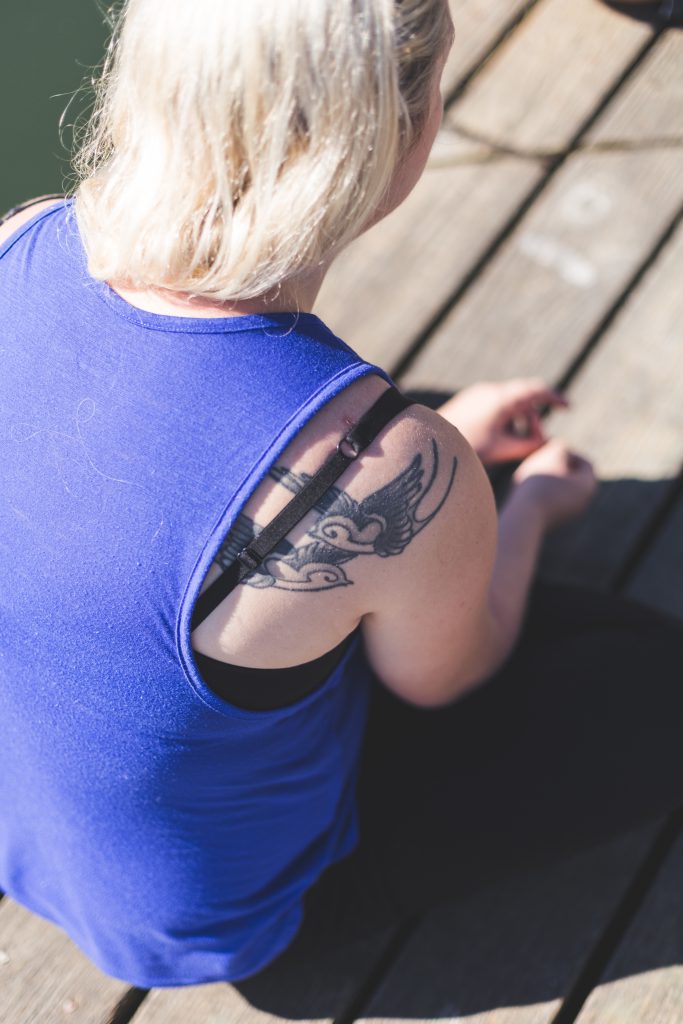Erin’s Story
A BEAUTIFUL TATTOO SITS ON THE BACK OF ERIN’S RIGHT SHOULDER. In it, two swallows fly towards each other, ready to embrace in a timeless dance.
The tattoo was a gift from an old friend, someone who Erin held very close to her heart. It was this friend who told her about the legendary symbolism of the swallow tattoos.
“Before I got the tattoo, my friend told me that back in time, sailors used to get swallows when they went on long and dangerous voyages,” Erin says. “They’d get one the day before they left, so that if their boat sank the swallow would take their soul up to heaven, and if they made it back, they’d get another one just to celebrate that they had survived all the struggles they faced during their trip.”
“I got two, and they’re meant to celebrate my mental health journey and symbolize that I survived through all my struggles.”

ERIN’S MENTAL HEALTH JOURNEY began over a decade ago.
At 13 she was already experiencing early signs of depression. She was constantly sad and irritable, for example, and often felt tired and unmotivated. Sometimes she’d spend all day in her room, unable to get out of bed.
“I just had this overwhelming feeling of heaviness that I didn’t understand and that I couldn’t really shake,” says Erin, who is 24 and lives in Victoria.
Although it was clear that Erin needed help, no one in her immediate circle knew what to do. At the time, they didn’t know much about mental health and had no clue what was wrong with her.
Because of this, her mental health challenges went undiagnosed and untreated for years, which according to a number of studies, decreases chances of successful recovery and increases the risk of having other challenges develop over time.
“Unfortunately, mental health was something people just never talked about, which meant that I never knew anything about it,” Erin says. “Since I didn’t know about it, I just let it go untreated, but the more I ignored it, the worse things got.”
Erin continues to work hard every day to stay healthy and keep her mental health in check.
OVER THE NEXT FEW YEARS, Erin’s mental health spiraled out of control.
“By the time I was 21 my depression had gotten worse, and I had developed symptoms that I later learned were of Post-Traumatic Stress Disorder,” Erin says. “I was super panicky all the time and began to drink a lot to cope with the pain.”
To make matters worse, that year Erin began to experience some new and highly worrying symptoms. She’d see things that weren’t there, for example, and had trouble recognizing if certain events in her life were real or not.
Although she didn’t know it at the time, what Erin was experiencing was the onset of psychosis, a condition where a person experiences unusual thoughts, behaviours, or beliefs, such as hearing or seeing things that others don’t.
“It was very scary because I had these very intense feelings that weren’t real, and I didn’t know what was going on,” she remembers. “I eventually ended up going to psychiatric emergency and that was the first time I heard about mental health challenges. Until then, I had no idea what was wrong with me, so I was really happy to finally start getting the help I so desperately needed.”
While she was at the hospital, Erin felt like she had hit rock bottom and was ready to embark on the second part of her journey: recovery.

ERIN’S ROAD TO RECOVERY began soon after she left the hospital. The first few steps of this long and winding journey were slow and deliberate. At first, she stayed at home a lot, doing her best to remain calm and find herself once again.
Once she felt confident enough in herself, she started going to the day hospital at the Eric Martin Pavilion in Victoria, where she received ongoing psychological treatment and learned a number of coping mechanisms that could help her deal with the mental health challenges she’d been facing for years.
It was there that she learned about the benefits of acupuncture, mindfulness, and yoga, three of the techniques she continues to use to achieve wellness.
“To be honest, going to the day hospital was life-changing. I didn’t only get help and learn so much there, but I also got to connect with people who had similar experiences to mine, which made me feel like I wasn’t completely alone anymore.”
Three years on, Erin continues to work hard every day to stay healthy and keep her mental health in check. To do this, she goes to therapy and attends regular support group meetings to deal with her substance use challenges.
When she isn’t taking care of herself, she also spends time helping other people who may be struggling with their own mental health, giving them the support that she didn’t have when she was growing up. To do this, she shares her story with as many young people as she can, with the hopes that they will be able to spot the signs and symptoms of mental health challenges in their own lives, so they can get help before things spiral out of control.
“In a way, I feel kind of cheated by some of the adults I encountered in my life,” Erin says. “If they would have known more about mental health and been able to teach me about it at a young age, it is possible that I could have faced my mental health challenges earlier and stopped things before they got worse.”
This story is part of a series aimed at sharing the experiences of young people across BC. As part of Foundry’s goal to work alongside young people, create connections and promote mental health and wellness, we are creating a platform for young people’s stories to be heard.
Article by Peter Mothe. Photography by Connor McCracken.
If you are in crisis, please call 1-800-784-2433.
Find out more about Foundry.